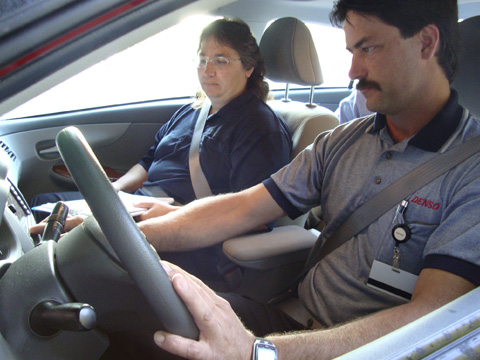Road Ready

“It’s very helpful to have an extra set of eyes and ears to focus on systems and how they interact.”
— Fred Volf, general manager of Quality at Toyota Motor
Manufacturing Canada
Faced with a steep final turn on the test track, Dan Urbaniak grips the steering wheel and gently presses the accelerator, crossing the finish point within a half second of his previous lap time.
Urbaniak, senior technician and vehicle evaluator, DENSO International America (DIAM) Test and Technical Services, successfully completes the road course training as part of his Nukata Testing education.
Nukata Testing—named after the DENSO test track in the mountainous Nukata district near DENSO in Japan (DNJP)—is used by DENSO to evaluate the interactions between vehicle systems and components in real-life driving scenarios.
DIAM recently developed its own capability to perform Nukata-style tests locally.
“With our training, we don’t require direct assistance from DNJP to perform tests here,” said Jason Hutchinson, senior engineer, DIAM Quality Engineering, and coordinator of evaluations.
“We still work in close collaboration with DNJP, but we’ve localized the effort.” Urbaniak and Hutchinson, along with DIAM’s Tracy Bray, senior technician and vehicle evaluator, DIAM Test and Technical Services, spent time with the Nukata Test Group in Japan to gain the know-how required for tests in North America.
DIAM also adopted a new name for the North American test team: DENSO Reliability Innovative Vehicle Evaluations, or DRIVE for short.
So how does it work? Vehicles with a high amount of DENSO product in them—usually pre-production or very early, full-production vehicles on loan from the customer—are subjected to rough roads, sloping hills and varied driving conditions for a full-vehicle evaluation.
Technicians spend about a week in the Environmental Drivability test chamber, and one week on a road track with each test vehicle. Road evaluations are often performed at local test tracks or a track provided by the customer.
“I don’t know of any suppliers that do full-vehicle evaluations,” said Bray. “It’s part of our overall quality efforts aimed at resolving potential problems with early detection and correction.”
After weeks of testing, all potential issues—both DENSO and non-DENSO—are identified, categorized, ranked for importance, and then shared with customers. If there’s an issue with a DENSO product, our engineers can correct the problem before it reaches consumers. Non-DENSO issues—problems that don’t have to do with our products—are typically shared for the customer’s benefit.
For example, in a recent DRIVE evaluation, technicians noticed a thumping noise made by an air conditioning component. The noise came when the driver changed HVAC modes—a problem that did not show up in “regular” bench tests, but did appear on the road track. DENSO engineers went to work on the potential driver annoyance.
“The tests are designed to surface any potential issues that might lead to a consumer warranty claim,” Bray said. “Even for products that aren’t ours, we pick up a lot of problems and potential problems that others might miss.”
And our customers recognize the added value that DRIVE-Nukata tests provide.
Fred Volf, general manager, Quality, at Toyota Motor Manufacturing Canada (TMMC), thanked DENSO for looking into non-DENSO issues. “It’s very helpful to have an extra set of eyes to focus on systems and how they interact,” Volf said.
Ed Wulbrecht, vice president of Quality Control at Subaru of Indiana, also expressed his appreciation. “This is a very valuable activity,” he said.
It’s this type of response from customers that makes DRIVE testing so valuable—for both customers and DENSO.
